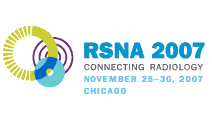
Abstract Archives of the RSNA, 2007
SSA01-04
Can Breast MRI CAD Improve the Diagnostic Accuracy of Screening MRI Detected Suspicious Lesions in a High-Risk Population?
Scientific Papers
Presented on November 25, 2007
Presented as part of SSA01: Breast Imaging (MR Imaging)
Tal Arazi-Kleinman MD, Presenter: Nothing to Disclose
Petrina A. Causer MD, Abstract Co-Author: Nothing to Disclose
Roberta A. Jong MD, Abstract Co-Author: Research collaboration, General Electric Company
Ellen Warner, Abstract Co-Author: Nothing to Disclose
Kimberley Hill, Abstract Co-Author: Nothing to Disclose
Donald B. Plewes PhD, Abstract Co-Author: Nothing to Disclose
To retrospectively evaluate the effect of MRI CAD on the radiologists’ sensitivity and specificity for breast MR screen detected lesions recommended for biopsy in a high risk population
Fifty six consecutive BI-RADS 3-5 lesions with histopathologic correlation (9 invasive cancers (IC), 13 ductal carcinoma in situ (DCIS) and 34 benign) detected on high risk patient screening MRI were retrospectively evaluated with breast MR CAD (CAD-Gaea). CAD evaluation was performed by 2 radiologists specializing in breast imaging, blinded to histopathology in consensus. Lesion enhancement at thresholds of 50, 80 and 100% and delayed enhancement were independently assessed with CAD. Lesions were rated as malignant or benign with respect to background parenchymal enhancement according to threshold and delayed enhancement only and in combination. Sensitivities and negative predictive values (NPV) were determined for final CAD assessments vs. pathology and for IC and DCIS independently. Initial MRI BI-RADS interpretation without CAD vs. CAD assessments were compared with paired binary diagnostic tests.
Discriminatory threshold levels for lesion enhancement were: 50% for all cancers, DCIS and all benign lesions; and 100% for all IC. The combined use of threshold and enhancement pattern information for CAD assessment was best (73% sensitivity, 56% specificity and 76% NPV for all cancer). However sensitivities and NPV were better for IC only (100%/100%) compared to DCIS only (54%/76%). Overall, radiologists' MRI interpretation was more sensitive than CAD (p=0.05), but less specific (p=0.001) for cancer detection in a high risk population.
Current breast MR CAD cannot improve the radiologists’ accuracy of distinguishing all malignant from benign screen MRI detected lesions, due to the poor sensitivity for DCIS detection.
Current breast MRI CAD using lesion enhancement information only can improve specificity of radiologists' screening MRI interpretation, but is unreliable for DCIS detection limiting its utility.
Arazi-Kleinman, T,
Causer, P,
Jong, R,
Warner, E,
Hill, K,
Plewes, D,
Can Breast MRI CAD Improve the Diagnostic Accuracy of Screening MRI Detected Suspicious Lesions in a High-Risk Population?. Radiological Society of North America 2007 Scientific Assembly and Annual Meeting, November 25 - November 30, 2007 ,Chicago IL.
http://archive.rsna.org/2007/5007286.html

